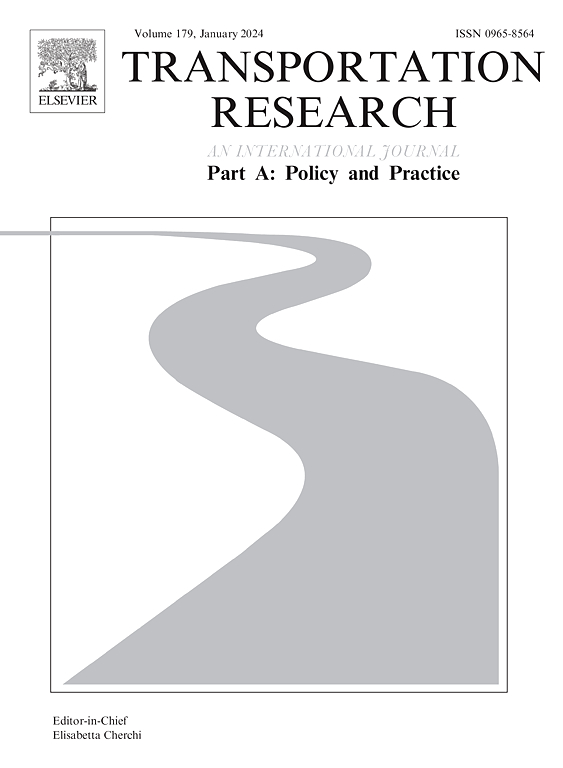公共交通领域的数字支付应用:发展中城市中模式选择环节的中介作用
IF 6.3
1区 工程技术
Q1 ECONOMICS
Transportation Research Part A-Policy and Practice
Pub Date : 2024-11-25
DOI:10.1016/j.tra.2024.104319
引用次数: 0
摘要
在技术进步的推动下,数字支付的出现正在彻底改变我们交易和支付商品与服务的方式,开创了便捷高效的时代。这些系统的众多优势促使公共交通机构纷纷采用。在早期阶段,有必要了解影响此类技术应用的因素。虽然交通领域的研究有限,但主要集中在移动票务方面,或在采用数字支付技术之前进行。前者在发展中国家尚未普及,因为这些国家仍采用人工驱动系统。本研究采用潜类聚类分析(LCCA)的细分方法,通过决策树、随机森林和 XGBoost 等 ML 分类算法,对每个聚类和全部数据进行分析,从而评估采用数字支付的影响因素。作为模型指标的行程参数和作为协变量的社会人口结构被输入到 LCCA 中,从而产生了七个聚类,分别为满意的 P.T. 用户(24.48 %)、关注访问的 IPT 用户(20.22 %)、满意的 MTW 用户(12.91 %)、关注信息的 MTW 用户(12.16 %)、关注舒适的汽车用户(11.21 %)、关注安全的 Captive P.T. 用户(10.09 %)和关注舒适的 MTW 用户(8.93 %)。对模型预测结果、准确率和重要特征进行比较后发现,XGBoost 在大多数群组中表现最佳。结果表明,不同的细分市场表现出不同的特性。之前使用过旅行应用程序、拥有的手机类型、互联网可用性和年龄都对数字支付的采用有很大影响。这项研究强调了了解不同用户群并相应调整数字支付技术以促进其在公共交通领域应用的重要性。这项研究可以帮助政策制定者制定技术决策并鼓励使用技术。未来的研究可以探讨乘客的态度问题,并采用先进的分析方法进行进一步探索。本文章由计算机程序翻译,如有差异,请以英文原文为准。
Digital payment adoption in public transportation: Mediating role of mode choice segments in developing cities
The emergence of digital payments, propelled by technology advancements, is revolutionising how we transact and pay for goods and services, ushering in the era of convenience and efficiency. The numerous benefits of these systems have prompted public transportation agencies to implement them. Understanding the factors influencing such technology adoption in the early stages is necessary. While limited research in the transportation sector exists, it is mainly focused on mobile ticketing or conducted before the adoption of digital payment technology. The former is not yet widespread in developing countries as they still have a human-driven system. This study presents a two-step methodology for analysing the population using a segmentation approach done using Latent class cluster analysis (LCCA) and thereby analysing each cluster and total data to evaluate the factors influencing the adoption of digital payments through ML classification algorithms – Decision trees, Random Forest and XGBoost. Trip parameters as model indicators and socio-demographic constructs as covariates are input to LCCA, resulting in seven clusters labelled Satisfied P.T. Users (24.48 %), Access-Concerned IPT Users (20.22 %), Satisfied MTW Users (12.91 %), Information-Concerned MTW Users (12.16 %), Comfort-Concerned Car Users (11.21 %), Safety-Concerned Captive P.T. Users (10.09 %) and Comfort-Concerned MTW Users (8.93 %). A comparison of the model predictions, accuracies and important features highlights that XGBoost is best performing for most of the clusters. Results indicated that the different segments exhibit different properties. Prior use of travel apps, type of phone owned, internet availability, and age significantly influence the adoption of digital payment. The study highlights the importance of understanding the different user segments and tailoring the digital payment technologies accordingly to promote their adoption in Public transportation. The study can help policymakers shape technological decisions and encourage technology use. Future studies can explore the attitudinal aspects of commuters and employ advanced analytical methods for further exploration.
求助全文
通过发布文献求助,成功后即可免费获取论文全文。
去求助
来源期刊
CiteScore
13.20
自引率
7.80%
发文量
257
审稿时长
9.8 months
期刊介绍:
Transportation Research: Part A contains papers of general interest in all passenger and freight transportation modes: policy analysis, formulation and evaluation; planning; interaction with the political, socioeconomic and physical environment; design, management and evaluation of transportation systems. Topics are approached from any discipline or perspective: economics, engineering, sociology, psychology, etc. Case studies, survey and expository papers are included, as are articles which contribute to unification of the field, or to an understanding of the comparative aspects of different systems. Papers which assess the scope for technological innovation within a social or political framework are also published. The journal is international, and places equal emphasis on the problems of industrialized and non-industrialized regions.
Part A''s aims and scope are complementary to Transportation Research Part B: Methodological, Part C: Emerging Technologies and Part D: Transport and Environment. Part E: Logistics and Transportation Review. Part F: Traffic Psychology and Behaviour. The complete set forms the most cohesive and comprehensive reference of current research in transportation science.

 求助内容:
求助内容: 应助结果提醒方式:
应助结果提醒方式:


